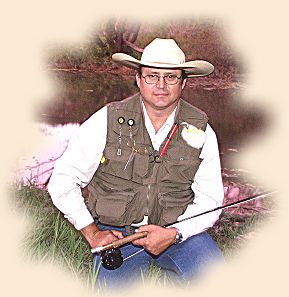I live and breathe fly fishing. I am one with the fly rod. See
the fish, be the fish. Now what looks good to the fish?
I spend a lot of time on the creek in my backyard, sometimes
just sitting along the bank and watching the panfish and bass
to see what they are feeding on and what traits they display
throughout the days of our seasons.

On this particular afternoon in mid January it's a balmy 72
degrees with a lot of sunshine warming the shallows in the
creek and producing a large hatch. Looking out across the
water there are areas covered in clouds of white produced
by the sun reflecting of the tiny wings of Caddis Flies.
They are emerging by the hundreds. Tiny B-52's no more
than two to three inches off the water and moving downstream.
Vee-wakes are starting to show on the surface. The predators
are starting to move. For the observant fly fisher, this is
a sign that catching fish is about to become a very good
possibility.
Winter time means less food sources. Hoppers, ants, caterpillars
and other forms of terrestrials are not present as well as other
forms of food sources. So if a hatch is occurring, this is
when the fish will be active, but selective. I have stood
in the creek with rings forming on the surface all around
me, casting surface flys with few to no hits. It is a
common mistake to assume that the surface rings mean the
fish are actually feeding on the surface, especially during
the winter. You can throw just about every surface fly out
there and they just wont touch it. Even the
Texas Midge Fly does not produce consistently every day.

Now is the time for Nymphs. This calls for totally different
tactics from the summer fishing. Throughout most of our winter,
nymphs and streamers consistently produce more fish than surface
flys. With the cooler water temperatures our warm water fish
will react slower and conserve as much energy as possible.
They will not tend to rise unless there is a warm sunny day
producing a consistent food source such as the hatches.
There are several methods for using and presenting nymphs. All
of them have worked for someone somewhere. I won't pretend to
be an expert, but let me share a method which has worked very
well for me. First of all the warmest part of the day in in
the late afternoons. Typically I will see rings starting to
form around 3:30 pm or later on any sunny warm day. Using
small unweighted nymphs (my preference is the gold ribbed
hares ear) about size 14, cast downstream. Allow the nymph
time to settle to the bottom and then slowly strip it back
allowing it to bump bottom. Depending on the leader length,
rod length and creek depth, when the nymph is near enough
to affect it's depth by simply lifting the rod, do so in a
slow steady manner until the nymph breaks the surface. If
at this point you have not caught anything pick up and re-cast.
This only works in very slow currents, usually eddies or pools
formed buy slow currents and natural obstructions. This gives
the angler three strike zones to actively fish.
The first is on the bottom where most fish will be in our
creeks during the winter months. Here they will take a nymph
on chance one just happens to pass by. A good example of this
is for bass fishing. During the summer top water is always
very productive. However during the winter, weighted streamers,
nymphs and baitfish simulators on bottom worked slowly is
usually the only way to get bass. And the bite is gentle
and hard to tell from bottom snags. Not the typical fierceness
you hear about bass fishing.
The second is the nymphs ascension to the surface. This is
where you are lifting the rod tip to slowly bring the nymph
to the surface. This simulates a nymph ready to start it's
adult life and the stage we do not see during the hatch.
This is where most of the strikes come. It's a very satisfying
feeling when you are lifting the rod and a nice panfish takes
the nymph. There is no mistaking this as a bite! However
this is also where it can be lost too. They are quick to
release it upon finding resistance and/or lack of taste.
At this point one of two things sets the hook. Take your
line hand and sharply give the line a good tug to set the
hook or lift the rod tip slightly faster without snapping
the line.
The final stage often creates a lot of confusion for both
the fly fisher and the fish. This is where the nymph just
breaks the surface and two things happen at once. To the
fish it signals the adult stage of the insect and it is
escaping food! To the fly fisher it time for pick up and
re-cast. This is what usually happens. The fly fisher
sees the nymph break the surface and begins his or hers
pickup for re-cast at the same time the fish sees dinner
escaping. At this point the panfish slams the nymph at
the same time the fly fisher is picking up! Now we have
a very surprised fly fisher with a suddenly very heavy
fly rod with an equally surprised panfish sailing through
the air! I have actually seen a fly fisher get slapped
in the face by a panfish!
So there you have it, one of the secrets to catching warm
water fish throughout the winter here in Central Texas.
Ya'll come on down . . . the fishing is good! ~ Johnny (Hillfisher)
|



